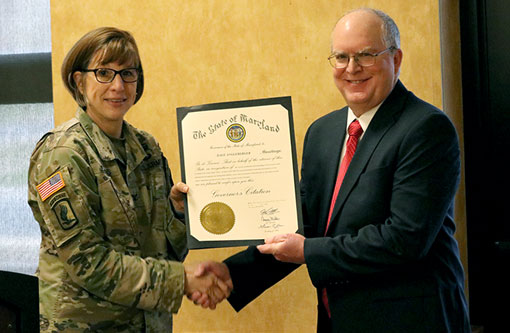USAMRIID Chief Information Officer, Dale Angleberger, Retires after 34 Years

After a 34-year career with the United States Army Medical Research Institute of Infectious Diseases, Dale Angleberger retired Mar. 31, 2023, as Chief Information Officer.
A former middle school Math teacher, Angleberger's journey with USAMRIID began in 1989 through a Summer Associateship Program for High School Science and Mathematics Faculty. His early contributions quickly led to a full-time civilian position in the Bioinformatics Office. In his first assignment he co-authored six scientific papers that helped identify mosquito breeding grounds using satellite imagery in support of Rift Valley Fever virus research projects in the Virology Division.
In the early 1990's, with a team of nine people, he worked on computerized databases and participated in the design, acquisition, and deployment of many technologies that are still in use throughout the Institute.
"The journey started with typewriters with carbon paper," he said. "My first portable computer was 25 pounds with a five-inch screen, and it was a box–that was a personal computer."
Angleberger said there were times when he felt short-sighted and couldn't see the next big thing coming in the world of technology–but when the industry and the Institute grew and changed, he changed with them. He oversaw the software upgrades of the USAMRIID legacy systems in response to the infamous Y2K Millennium Bug, which resulted in no loss of data or capability. He helped establish the U.S. Army Medical Research and Development Command's first Food and Drug Administration-compliant Clinical Data Management System. It was used in managing clinical trials, conducted under internationally recognized Good Clinical Practice guidelines, for medical countermeasures against anthrax, dengue, and some 20 other biological threats.
The world of information technology was always a challenge, Angleberger said, and communicating those challenges with personnel who did not understand the technical side of the work presented further difficulties. However, he and his hand-picked team of IT personnel always found a way. When called for support, for example, he would show the customers the debug software, provide a rundown of what was happening within the system, and give them an idea of the work entailed to bring it back online.
"Early in my career I was technical, building databases and developing systems, but my forte is really communicating technical information to non-technical people," he said. "I always asked, what do they need to know?"
If you ask his team members, the most difficult challenge the Information Management Division faces is supporting the scientific mission of USAMRIID while conforming to Army and DoD cybersecurity requirements. Joshua Garvey, the new Chief Information Officer, said Angleberger was instrumental in helping the division to meet this challenge through the creation and support of the RIID Science Network, which is the standalone network for all scientific equipment at USAMRIID.
Having worked with Angleberger for many years, Garvey said, "There are too many things I have learned from Dale over my career to pick just one, but if I had to narrow it down, I would say it is how to be a good leader and listen to an entire situation."
"Dale was always levelheaded; he would get as much information as possible and then make the appropriate decision. He was the consummate leader that I will continue to aspire to be," said Garvey.













